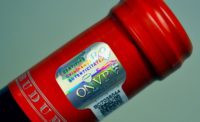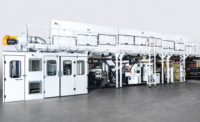Intelligent labels — applicable in product categories such as beauty, food, grocery, beverage or apparel — are providing never-before seen connectivity for consumers and supply chain segments. Thanks to the internet of things (IoT) and the desire to incorporate technology into everyday products, labels are counted on to deliver more to everyone in the value chain.
Enhancing the consumer experience by providing more information, direct brand interaction and, yes, entertainment, is maximizing the brand experience well beyond store shelves. Consumers look to technology to make their lives more entertaining, manageable and efficient. They seek information about products prior to, during and after a purchase. Via their smartphones, consumers are interacting with brands as never before, thanks to intelligent labels.
The supply chain can use intelligent labels beyond the consumer experience. Track and trace, instant inventories and proving authenticity to prevent or reduce counterfeiting and product tampering while protecting both the brand and its users are just three ways intelligent labels optimize supply chain activities.. Brands know that they have to engage with their consumer at the shelf and rack, but they also need to optimize their supply chain activities and, in some cases, add a level of authentication to prevent counterfeiting or tampering.
Intelligent labels bridge the material and the digital to provide solutions to branding and supply chain needs. The solutions grow by the day as the “what if?” question is addressed by labeling expertise.
The Engaged Consumer
Avery Dennison research indicates that e-commerce is projected to grow 21 percent this year, reaching nearly $560 billion. Consumers shop online due to ease and speed. Fast, free shipping is becoming a given, not a perk. And by the end of 2020, it’s estimated that a third of all grocery sales will be online.
That said, e-commerce has changed buying habits in brick and mortar settings. Consumers seek new in-store experiences, expecting more information or interaction, than that provided by a traditional end-cap or aisle display. That’s where intelligent labels — and the fact that 77 percent of all Americans own smartphones — can make a significant difference. Brands can compete on the retail floor by reaching customers via RFID labels equipped with near field communication (NFC) technology for in-store interaction. More significantly, the label can continue to interact with the buyer after the purchase.
The label offers ease of connection and may be seamlessly integrated into package design. By connecting with an NFC-enabled smartphone, it can give the product a “voice” and send direct messages to consumers both before and after a purchase. It can deliver a customer journey via augmented reality that not only engages the consumer, but provides touch points beyond the sale by delivering recipes, instructions or product manuals, special offers, games, direct interaction or loyalty programs.
Such labels provide one-to-one communication. They’re fast and easy to use by simply tapping the phone to the product. There’s no app to download, and the information provided via NFC doesn’t take up valuable branding real estate on the label or packaging itself.
Take for example a high-end bottle of liquor or wine. The NFC-enabled label may be incorporated into the bottle’s seal, helping to indicate whether a product has been tampered with while still on the shelf. Consumers who access the label via their smartphone while the product is still on the shelf may receive the brand’s story, or may be enticed with recipes or ideas about how to use the product. Better still, it offers brands a direct insight into how and when their products are being used, or how many different products from that brand have been accessed by the same phone, providing a window into purchasing behavior,
The Engaged Supply Chain
From manufacturer to consumer, RFID tagged items can provide benefits along the product’s journey. These include:
- Creating alerts for date-expired and short-life products
- Improving visibility of use-by dates, resulting in fewer markdowns through enhanced expiration management
- Automating mark-down process through RFID tag scanning linked to label printer
- Enhancing inventory accuracy and speed of taking inventory
- Boosting staff productivity
- Reducing net food waste in store
- Improving availability and sales
- Establishing more efficient handling of recalls
Authentication has also been enabled by RFID solutions using blockchain technology. Counterfeit products abound worldwide. The largest counterfeit products market is pharmaceuticals, estimated at $200 billion alone, but fake goods exist in markets that range from high-end wines and foods to designer clothing and accessories.
A great example is that of Beef Chain, which uses RFID and blockchain technology to authenticate a product – Wyoming beef – from ranch to restaurant table. This solution solves the issue of proving that the product being marketed as authentic Wyoming beef actually is Wyoming beef, thus justifying the premium price charged to consumers. The RFID solution tracks the product from the animal as it is raised in Wyoming, to the processing plant, and through distribution channels all the way to a restaurant table. It allows diners to interact with their menu and be directed to the rancher’s website to learn more about their practices that deliver renowned beef products – providing full value to all involved in the supply chain, literally from ranch to table.
Forward Thinking
Intelligent label technology is all around us, even at times when we’re not aware of it. A major airline has adopted RFID technology for its luggage tagging system, significantly reducing the amount of lost baggage and the labor hours wasted trying to match lost luggage with owners. They also included a bag tracking function in their app to ease consumers’ stress and provide information about when their bag is in transit and when it arrives at the plane.
Avery Dennison recently introduced WaveSafe, an RFID-enabled label specifically designed for item tagging of frozen packaged foods that might face unintentional microwave exposure. This ensures that if the item happens to be placed in the microwave, possibly for a defrost cycle, it can safely withstand this exposure while the tag remains on the packaging; there is no danger of accidental sparking.
Applying intelligent labeling technology in any application is really a function of being a solution to a problem. Working with experienced converters and RFID label suppliers is the key to providing that solution.





